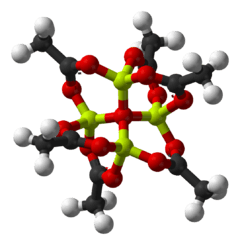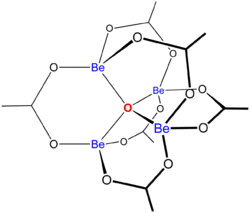Basic beryllium acetate
 | |
| Names | |
|---|---|
| Systematic IUPAC name
Hexakis(μ-acetato)-μ(sup 4)-oxotetraberyllium | |
| Other names
Beryllium oxyacetate Beryllium oxide acetate | |
| Identifiers | |
| ChemSpider | |
| ECHA InfoCard | 100.038.881 |
| EC Number | 242-785-4 |
PubChem CID |
|
| Properties | |
| C 12H 18Be 4O 13 | |
| Molar mass | 406.3122 g/mol |
| Appearance | colorless |
| Melting point | 285 °C (545 °F; 558 K) |
| Boiling point | 330 °C (626 °F; 603 K) |
| Solubility in chloroform | soluble |
| Hazards | |
| Main hazards | highly toxic |
| US health exposure limits (NIOSH): | |
PEL (Permissible) |
TWA 0.002 mg/m3 C 0.005 mg/m3 (30 minutes), with a maximum peak of 0.025 mg/m3 (as Be)[1] |
REL (Recommended) |
Ca C 0.0005 mg/m3 (as Be)[1] |
IDLH (Immediate danger) |
Ca [4 mg/m3 (as Be)][1] |
Except where otherwise noted, data are given for materials in their standard state (at 25 °C [77 °F], 100 kPa). | |
| Infobox references | |
Basic beryllium acetate is the chemical compound with the formula Be4O(O2CCH3)6. Although this compound has no applications and has been only lightly studied, it adopts a distinctive structure. The compound is a colourless solid that is soluble in organic solvents.
Preparation
It can be prepared by treating basic beryllium carbonate with hot acetic acid.
- 2 Be
2CO
3(OH)
2 + 6 AcOH → Be
4O(AcO)
6 + 5 H
2O + 2 CO
2
Basic beryllium acetate is insoluble in water but soluble in chloroform, consistent with it being nonpolar. It melts and sublimes in a vacuum without decomposition.[2]
Structure
"Basic acetates" consist of an ensemble of metal centres bound to a central oxide ion, and a collection of acetate ligands. Basic beryllium acetate has a tetrahedral Be4O6+ core with acetates (CH3CO2−) spanning each of the pairs of Be2+ centres.[3][4] It consists of interlocking six-membered Be2O3C rings. The structure is relevant to its considerable stability (the compound is distillable at 330 °C).

See also
- Basic zinc acetate - isostructural
References
- 1 2 3 "NIOSH Pocket Guide to Chemical Hazards #0054". National Institute for Occupational Safety and Health (NIOSH).
- ↑ Moeller, T. (1950). "Basic Beryllium Derivatives of Organic Acids". In Audrieth, L. F. Inorganic Syntheses, Volume 3. John Wiley & Sons. p. 4. doi:10.1002/9780470132340.ch2. ISBN 978-0-470-13234-0.
- ↑ Bragg, W. H. (1923). "Crystal Structure of Basic Beryllium Acetate". Nature. 111 (2790): 532. Bibcode:1923Natur.111..532B. doi:10.1038/111532a0.
- ↑ Pauling, L.; Sherman, J. (1934). "The Structure of the Carboxyl Group. II. The Crystal Structure of Basic Beryllium Acetate". Proceedings of the National Academy of Sciences. 20 (6): 340. Bibcode:1934PNAS...20..340P. doi:10.1073/pnas.20.6.340.
Acetyl halides and salts of the acetate ion | |||||||||||||||||||
|---|---|---|---|---|---|---|---|---|---|---|---|---|---|---|---|---|---|---|---|
| AcOH | He | ||||||||||||||||||
| LiOAc | Be(OAc)2 BeAcOH |
B(OAc)3 | AcOAc ROAc |
NH4OAc | AcOOH | FAc | Ne | ||||||||||||
| NaOAc | Mg(OAc)2 | Al(OAc)3 ALSOL Al(OAc)2OH Al2SO4(OAc)4 |
Si | P | S | ClAc | Ar | ||||||||||||
| KOAc | Ca(OAc)2 | Sc(OAc)3 | Ti(OAc)4 | VO(OAc)3 | Cr(OAc)2 | Mn(OAc)2 Mn(OAc)3 |
Fe(OAc)2 Fe(OAc)3 |
Co(OAc)2, Co(OAc)3 |
Ni(OAc)2 | Cu(OAc)2 | Zn(OAc)2 | Ga(OAc)3 | Ge | As(OAc)3 | Se | BrAc | Kr | ||
| RbOAc | Sr(OAc)2 | Y(OAc)3 | Zr(OAc)4 | Nb | Mo(OAc)2 | Tc | Ru(OAc)2 Ru(OAc)3 Ru(OAc)4 |
Rh2(OAc)4 | Pd(OAc)2 | AgOAc | Cd(OAc)2 | In | Sn(OAc)2 Sn(OAc)4 |
Sb(OAc)3 | Te | IAc | Xe | ||
| CsOAc | Ba(OAc)2 | Hf | Ta | W | Re | Os | Ir | Pt(OAc)2 | Au | Hg2(OAc)2, Hg(OAc)2 |
TlOAc Tl(OAc)3 |
Pb(OAc)2 Pb(OAc)4 |
Bi(OAc)3 | Po | At | Rn | |||
| Fr | Ra | Rf | Db | Sg | Bh | Hs | Mt | Ds | Rg | Cn | Nh | Fl | Mc | Lv | Ts | Og | |||
| ↓ | |||||||||||||||||||
| La(OAc)3 | Ce(OAc)x | Pr | Nd | Pm | Sm(OAc)3 | Eu(OAc)3 | Gd(OAc)3 | Tb | Dy(OAc)3 | Ho(OAc)3 | Er | Tm | Yb(OAc)3 | Lu(OAc)3 | |||||
| Ac | Th | Pa | UO2(OAc)2 | Np | Pu | Am | Cm | Bk | Cf | Es | Fm | Md | No | Lr | |||||